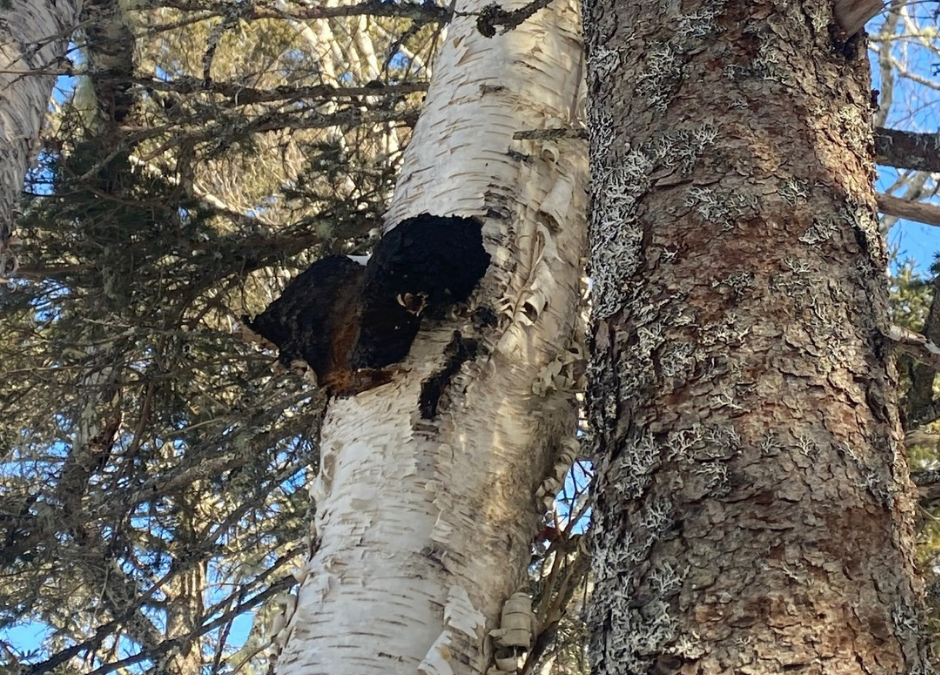by Gren Blackall
Chaga doesn’t look the part as foragers’ treasure in the Maine woods. But it is. The odd shaped hard black bumpy fungus looks more like an accident than the world’s most antioxidant rich superfood!
How super? The National Institute of Health devised a measure of antioxidant levels in food called ORAC, or Oxygen Radical Absorbance Capacity. Tufts University applied it to various foods and came up with rankings (as reported by IntegrativeHealthInstitute.ca). Blueberries have 24 ORAC units per gram. Pomegranates, touted by sellers for their high antioxidant levels, have 34 ORAC units per gram. The Acais berry beats both with 41. Chaga topped all food tested with a knee buckling 366 ORAC units per gram! Boom.

Figure 2 I’m cutting the chaga off the tree.
Finding Chaga: Chaga likes cold northern climates, which is why Maine is one of the few US States with a supply. Search in deeply wooded areas where evergreens and birches dominate. I’ve personally seen it in Maine coastal downeast woods. I find it on yellow birch trees in a clump, known as a ‘conk’.
Think burnt knobby charcoal. Beneath the charred surface you’ll find a woody orange tinted center.
Chaga looks like it extruded from the tree. It has none of the symmetry or layered look of other tree mushrooms. Conks are hard as wood throughout, with not a single soft spot, and each has a completely unique random shape. (Look up Horseshoe Mushroom for a common tree fungus that is NOT Chaga.)

Figure 1 The chaga conk (lower one) I harvested for this article.
Search the internet and you’ll find many Chaga accolades. Although no human studies have been conducted, according to Healthline.com, “Animal and test-tube studies found that chaga extract may boost immunity, prevent chronic inflammation, fight cancer, lower blood sugar levels and reduce cholesterol.” Like any medicinal supplement however, individuals need to check with their doctor about drug interactions and other risks.
How to you harvest it? Start by finding it. What a thrill to come across a chunk reachable with a pruning saw.

Figure 3 Close up of a nice conk of chaga.
Cut it down: Only harvest Chaga with permission. I’m lucky to have some in my back yard. The forager pros say to harvest in winter when the Chaga has pulled the most nutrient from the tree. I use an extendable pruning saw. It takes more effort to cut than expected. Don’t cut close to the tree so you leave some behind to regrow next season.
Chisel off the black exterior: While nothing bad lives in the outer black layer, this part adds no nutrient or flavor. So I recommend chipping off what you can.
Pulverize it: Chisel into bite-sized pieces. I wrap each piece in a clean rag (that I toss afterwards). Then smash the heck out of it with a hammer or meat tenderizer.

Figure 4 Chipping off the black exterior of chaga.

Figure 5 Chunks of the cleaned chaga before pulverizing.

Figure 6 Pulverizing chaga before putting in the blender.
Blend it into powder: As long as the pieces are small, use a regular blender to turn the Chaga to powder. Do it in small batches.
Consume it: Chaga shares nothing visually with its cap and gill mushroom fungi relatives. Yet the taste reveals a distinctive earthy flavor reminiscent of sauteed mushrooms, with a tiny dash of vanilla. I add a teaspoon of Chaga powder to my daily French-press pot of loose-leaf tea. Do your own research on the right quantity.
Other methods: Some boil the chunks and filter off the dark brown liquid. Some reduce it to a tincture. Some put the powder into gel caps and swallow it. Some drink it plain, hot or iced. Personally, I like mixing it with tea or coffee.
Freeze it. If kept in the freezer, Chaga chunks or powder can last indefinitely. The amount I harvested for this article will last me close to a year.

Figure 7 My daily chaga tea mixture.
Just saying, I feel a little thrill every morning knowing I’m adding a thoroughly natural, extremely local, virtually unprocessed, superfood to my diet!
Gren Blackall lives on Wohoa Bay in Addison Maine and is a Downeast Coastal Conservancy Board of Director. This is article relates his experience and does not constitute an endorsement by DCC Individuals are encouraged to do their own research on chaga before consuming.

